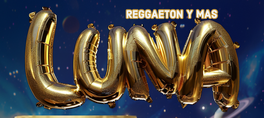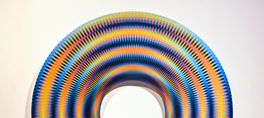Ann Weber
March 5–28, 2015
Artist Talk: Saturday, March 7, 2:00
Dolby Chadwick Gallery is pleased to announce an exhibition of new work by Ann Weber. Weber has drawn praise for her ability to commute the everyday into the extraordinary, utilizing found cardboard to create poignant, sensuous, and often anthropomorphic forms.
For her large-scale “Personages” works, Weber first constructs an internal, three-dimensional armature in cardboard that she then wraps with strips of cardboard measuring no more than a couple of inches wide. The resulting surface textures shift from alternating waves that overlap at a steady cadence to tightly woven crosshatchings to a “coiling” that recalls her earlier work as a potter and training under Viola Frey. These tall, upright pieces bear striking resemblance to the human body, an effect that is amplified by the artist’s proclivity for grouping multiple sculptures into a single work, thereby alluding to our natural sociality and desire to find connection—within a clan, a family, or a relationship.
This attention to human bonds and belonging is evident in a work like Personages (We Three) (2013), for example. Here, two sculptures with ample waists that taper off at the top and base hug a central sculpture that grows lean around its middle, echoing the female form. Their negative and positive spaces complete one another, generating a coherence that would collapse with the removal of any one of the individual parts. Indeed, the very creation of each part is contingent on the others, since the material leftover from one structure’s armature serves as the armature for the next. These works, which Weber made during a “period of obstacles” in her life, serve as an homage to the legions of people that looked after her. Weber explains that “illustrating relationships—belaboring how important they are—is central to my work.”
Weber’s wall sculptures, on view in this exhibition, develop out of and utilize a process similar to that of her “Personages.” The first group of reliefs was inspired by stays in Italy, most recently as Visiting Artist at the American Academy of Rome. Weber points to her fascination with Bernini and his unique facility for articulating in marble the folds of fabric. Works such as Pluto (2014) and After Bernini (Charity) (2014) show Weber capturing the abstract details of this drapery without losing sight of the larger picture: the way in which the fabric falls is necessarily determined by the curve of the human form—or forms—that the fabric cloaks. In an interesting twist, Weber has looked to the high academic style of the seventeenth-century Italian Baroque to create work that is rooted in Arte Povera, an industrious Italian art movement of the 1960s and ’70s led by Michelangelo Pistoletto that advocated simple forms, everyday materials, and the breakdown of stringent art world hierarchies. Weber explains how “the absurdity of using cardboard comes from Art Povera. Marble is really rough looking in its natural form, and I like this idea of creating beauty from such a rough material. Similarly, with cardboard, I like tempting beauty with such a mundane material.”
Two works—titled After Ellsworth (Yellow) (2014) and After Ellsworth (Green) (2014)—bear similarities to Weber’s Roman wall reliefs but were informed by Ellsworth Kelly’s Spectrum V (1969), thirteen large paintings-cum-sculptures that each represent a single hue along the color spectrum. Weber was inspired by Kelly’s use of color and insistence that “presence” is just as important as mark-making. In Weber’s work we see this emphasis on presence via the arresting relationships she creates through form and color but also through her choice of material, which asserts itself in ways that are often more memorable than the traditional marbles or precious bronzes of old masterworks.
Ann Weber was born in 1950 in Jackson, Michigan, and earned her BA in art history from Purdue University in 1972. After living in New York, Weber moved to California to pursue her MFA at the College of Arts and Crafts in Oakland, where she studied with Viola Frey. Weber has shown at the San Jose Museum of Art; the Oakland Museum of California; the Boise Art Museum, Idaho; and the Evansville Art Museum, Indiana, among others. She was the subject of a solo exhibition at the Craft and Folk Art Museum in Los Angeles and has held residencies at the de Young, Fine Arts Museums of San Francisco; the American Academy in Rome; and the Lux Art Institute outside of San Diego. Her cardboard sculptures have been cast in bronze and fiberglass for public art projects in Phoenix, Denver, and Sacramento.
show less
March 5–28, 2015
Artist Talk: Saturday, March 7, 2:00
Dolby Chadwick Gallery is pleased to announce an exhibition of new work by Ann Weber. Weber has drawn praise for her ability to commute the everyday into the extraordinary, utilizing found cardboard to create poignant, sensuous, and often anthropomorphic forms.
For her large-scale “Personages” works, Weber first constructs an internal, three-dimensional armature in cardboard that she then wraps with strips of cardboard measuring no more than a couple of inches wide. The resulting surface textures shift from alternating waves that overlap at a steady cadence to tightly woven crosshatchings to a “coiling” that recalls her earlier work as a potter and training under Viola Frey. These tall, upright pieces bear striking resemblance to the human body, an effect that is amplified by the artist’s proclivity for grouping multiple sculptures into a single work, thereby alluding to our natural sociality and desire to find connection—within a clan, a family, or a relationship.
This attention to human bonds and belonging is evident in a work like Personages (We Three) (2013), for example. Here, two sculptures with ample waists that taper off at the top and base hug a central sculpture that grows lean around its middle, echoing the female form. Their negative and positive spaces complete one another, generating a coherence that would collapse with the removal of any one of the individual parts. Indeed, the very creation of each part is contingent on the others, since the material leftover from one structure’s armature serves as the armature for the next. These works, which Weber made during a “period of obstacles” in her life, serve as an homage to the legions of people that looked after her. Weber explains that “illustrating relationships—belaboring how important they are—is central to my work.”
Weber’s wall sculptures, on view in this exhibition, develop out of and utilize a process similar to that of her “Personages.” The first group of reliefs was inspired by stays in Italy, most recently as Visiting Artist at the American Academy of Rome. Weber points to her fascination with Bernini and his unique facility for articulating in marble the folds of fabric. Works such as Pluto (2014) and After Bernini (Charity) (2014) show Weber capturing the abstract details of this drapery without losing sight of the larger picture: the way in which the fabric falls is necessarily determined by the curve of the human form—or forms—that the fabric cloaks. In an interesting twist, Weber has looked to the high academic style of the seventeenth-century Italian Baroque to create work that is rooted in Arte Povera, an industrious Italian art movement of the 1960s and ’70s led by Michelangelo Pistoletto that advocated simple forms, everyday materials, and the breakdown of stringent art world hierarchies. Weber explains how “the absurdity of using cardboard comes from Art Povera. Marble is really rough looking in its natural form, and I like this idea of creating beauty from such a rough material. Similarly, with cardboard, I like tempting beauty with such a mundane material.”
Two works—titled After Ellsworth (Yellow) (2014) and After Ellsworth (Green) (2014)—bear similarities to Weber’s Roman wall reliefs but were informed by Ellsworth Kelly’s Spectrum V (1969), thirteen large paintings-cum-sculptures that each represent a single hue along the color spectrum. Weber was inspired by Kelly’s use of color and insistence that “presence” is just as important as mark-making. In Weber’s work we see this emphasis on presence via the arresting relationships she creates through form and color but also through her choice of material, which asserts itself in ways that are often more memorable than the traditional marbles or precious bronzes of old masterworks.
Ann Weber was born in 1950 in Jackson, Michigan, and earned her BA in art history from Purdue University in 1972. After living in New York, Weber moved to California to pursue her MFA at the College of Arts and Crafts in Oakland, where she studied with Viola Frey. Weber has shown at the San Jose Museum of Art; the Oakland Museum of California; the Boise Art Museum, Idaho; and the Evansville Art Museum, Indiana, among others. She was the subject of a solo exhibition at the Craft and Folk Art Museum in Los Angeles and has held residencies at the de Young, Fine Arts Museums of San Francisco; the American Academy in Rome; and the Lux Art Institute outside of San Diego. Her cardboard sculptures have been cast in bronze and fiberglass for public art projects in Phoenix, Denver, and Sacramento.
Ann Weber
March 5–28, 2015
Artist Talk: Saturday, March 7, 2:00
Dolby Chadwick Gallery is pleased to announce an exhibition of new work by Ann Weber. Weber has drawn praise for her ability to commute the everyday into the extraordinary, utilizing found cardboard to create poignant, sensuous, and often anthropomorphic forms.
For her large-scale “Personages” works, Weber first constructs an internal, three-dimensional armature in cardboard that she then wraps with strips of cardboard measuring no more than a couple of inches wide. The resulting surface textures shift from alternating waves that overlap at a steady cadence to tightly woven crosshatchings to a “coiling” that recalls her earlier work as a potter and training under Viola Frey. These tall, upright pieces bear striking resemblance to the human body, an effect that is amplified by the artist’s proclivity for grouping multiple sculptures into a single work, thereby alluding to our natural sociality and desire to find connection—within a clan, a family, or a relationship.
This attention to human bonds and belonging is evident in a work like Personages (We Three) (2013), for example. Here, two sculptures with ample waists that taper off at the top and base hug a central sculpture that grows lean around its middle, echoing the female form. Their negative and positive spaces complete one another, generating a coherence that would collapse with the removal of any one of the individual parts. Indeed, the very creation of each part is contingent on the others, since the material leftover from one structure’s armature serves as the armature for the next. These works, which Weber made during a “period of obstacles” in her life, serve as an homage to the legions of people that looked after her. Weber explains that “illustrating relationships—belaboring how important they are—is central to my work.”
Weber’s wall sculptures, on view in this exhibition, develop out of and utilize a process similar to that of her “Personages.” The first group of reliefs was inspired by stays in Italy, most recently as Visiting Artist at the American Academy of Rome. Weber points to her fascination with Bernini and his unique facility for articulating in marble the folds of fabric. Works such as Pluto (2014) and After Bernini (Charity) (2014) show Weber capturing the abstract details of this drapery without losing sight of the larger picture: the way in which the fabric falls is necessarily determined by the curve of the human form—or forms—that the fabric cloaks. In an interesting twist, Weber has looked to the high academic style of the seventeenth-century Italian Baroque to create work that is rooted in Arte Povera, an industrious Italian art movement of the 1960s and ’70s led by Michelangelo Pistoletto that advocated simple forms, everyday materials, and the breakdown of stringent art world hierarchies. Weber explains how “the absurdity of using cardboard comes from Art Povera. Marble is really rough looking in its natural form, and I like this idea of creating beauty from such a rough material. Similarly, with cardboard, I like tempting beauty with such a mundane material.”
Two works—titled After Ellsworth (Yellow) (2014) and After Ellsworth (Green) (2014)—bear similarities to Weber’s Roman wall reliefs but were informed by Ellsworth Kelly’s Spectrum V (1969), thirteen large paintings-cum-sculptures that each represent a single hue along the color spectrum. Weber was inspired by Kelly’s use of color and insistence that “presence” is just as important as mark-making. In Weber’s work we see this emphasis on presence via the arresting relationships she creates through form and color but also through her choice of material, which asserts itself in ways that are often more memorable than the traditional marbles or precious bronzes of old masterworks.
Ann Weber was born in 1950 in Jackson, Michigan, and earned her BA in art history from Purdue University in 1972. After living in New York, Weber moved to California to pursue her MFA at the College of Arts and Crafts in Oakland, where she studied with Viola Frey. Weber has shown at the San Jose Museum of Art; the Oakland Museum of California; the Boise Art Museum, Idaho; and the Evansville Art Museum, Indiana, among others. She was the subject of a solo exhibition at the Craft and Folk Art Museum in Los Angeles and has held residencies at the de Young, Fine Arts Museums of San Francisco; the American Academy in Rome; and the Lux Art Institute outside of San Diego. Her cardboard sculptures have been cast in bronze and fiberglass for public art projects in Phoenix, Denver, and Sacramento.
read more
March 5–28, 2015
Artist Talk: Saturday, March 7, 2:00
Dolby Chadwick Gallery is pleased to announce an exhibition of new work by Ann Weber. Weber has drawn praise for her ability to commute the everyday into the extraordinary, utilizing found cardboard to create poignant, sensuous, and often anthropomorphic forms.
For her large-scale “Personages” works, Weber first constructs an internal, three-dimensional armature in cardboard that she then wraps with strips of cardboard measuring no more than a couple of inches wide. The resulting surface textures shift from alternating waves that overlap at a steady cadence to tightly woven crosshatchings to a “coiling” that recalls her earlier work as a potter and training under Viola Frey. These tall, upright pieces bear striking resemblance to the human body, an effect that is amplified by the artist’s proclivity for grouping multiple sculptures into a single work, thereby alluding to our natural sociality and desire to find connection—within a clan, a family, or a relationship.
This attention to human bonds and belonging is evident in a work like Personages (We Three) (2013), for example. Here, two sculptures with ample waists that taper off at the top and base hug a central sculpture that grows lean around its middle, echoing the female form. Their negative and positive spaces complete one another, generating a coherence that would collapse with the removal of any one of the individual parts. Indeed, the very creation of each part is contingent on the others, since the material leftover from one structure’s armature serves as the armature for the next. These works, which Weber made during a “period of obstacles” in her life, serve as an homage to the legions of people that looked after her. Weber explains that “illustrating relationships—belaboring how important they are—is central to my work.”
Weber’s wall sculptures, on view in this exhibition, develop out of and utilize a process similar to that of her “Personages.” The first group of reliefs was inspired by stays in Italy, most recently as Visiting Artist at the American Academy of Rome. Weber points to her fascination with Bernini and his unique facility for articulating in marble the folds of fabric. Works such as Pluto (2014) and After Bernini (Charity) (2014) show Weber capturing the abstract details of this drapery without losing sight of the larger picture: the way in which the fabric falls is necessarily determined by the curve of the human form—or forms—that the fabric cloaks. In an interesting twist, Weber has looked to the high academic style of the seventeenth-century Italian Baroque to create work that is rooted in Arte Povera, an industrious Italian art movement of the 1960s and ’70s led by Michelangelo Pistoletto that advocated simple forms, everyday materials, and the breakdown of stringent art world hierarchies. Weber explains how “the absurdity of using cardboard comes from Art Povera. Marble is really rough looking in its natural form, and I like this idea of creating beauty from such a rough material. Similarly, with cardboard, I like tempting beauty with such a mundane material.”
Two works—titled After Ellsworth (Yellow) (2014) and After Ellsworth (Green) (2014)—bear similarities to Weber’s Roman wall reliefs but were informed by Ellsworth Kelly’s Spectrum V (1969), thirteen large paintings-cum-sculptures that each represent a single hue along the color spectrum. Weber was inspired by Kelly’s use of color and insistence that “presence” is just as important as mark-making. In Weber’s work we see this emphasis on presence via the arresting relationships she creates through form and color but also through her choice of material, which asserts itself in ways that are often more memorable than the traditional marbles or precious bronzes of old masterworks.
Ann Weber was born in 1950 in Jackson, Michigan, and earned her BA in art history from Purdue University in 1972. After living in New York, Weber moved to California to pursue her MFA at the College of Arts and Crafts in Oakland, where she studied with Viola Frey. Weber has shown at the San Jose Museum of Art; the Oakland Museum of California; the Boise Art Museum, Idaho; and the Evansville Art Museum, Indiana, among others. She was the subject of a solo exhibition at the Craft and Folk Art Museum in Los Angeles and has held residencies at the de Young, Fine Arts Museums of San Francisco; the American Academy in Rome; and the Lux Art Institute outside of San Diego. Her cardboard sculptures have been cast in bronze and fiberglass for public art projects in Phoenix, Denver, and Sacramento.
show less
Date/Times:
Dolby Chadwick Gallery
1 Upcoming Events
210 Post Street, San Francisco, CA 94108
The Best Events
Every Week in Your Inbox
From Our Sponsors
UPCOMING EVENTS
Great suggestion! We'll be in touch.
Event reviewed successfully.









